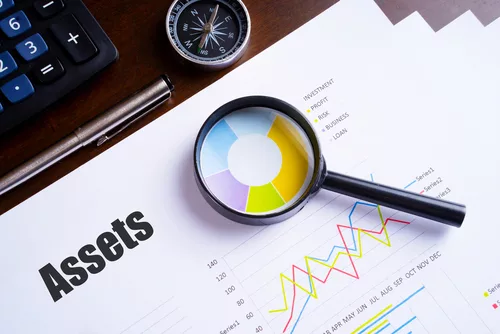- Posted on
- Kortney Murray
- 0
As a business, it can become difficult to keep up to date with and identify all the assets an organization owns. This can make effectively managing all the assets a company owns a problem that affects running business operations efficiently. To solve this problem, many companies make asset labeling to keep track of their assets.
Asset labeling is widely practiced in many businesses and is used as a means to quickly identify a company’s assets. But what is it and how exactly does it work? Here is your definitive guide to asset labeling.

What Is Asset Labeling?
Businesses today have a wide range of assets that facilitate their operations. These assets are frequently managed and accounted for to keep the business running efficiently. One of such asset management techniques is asset labeling. When an organization owns lots of assets and equipment, it is essential to keep track of these assets.
Without keeping track of these assets, businesses risk asset losses that severely affect the organization. As a result, many people use asset labeling to keep track of their business assets to ensure these assets are accounted for. But what exactly is asset labeling?
Asset labeling is the simple process of labeling or tagging an asset. It is usually done to assign fixed assets with unique identities that make them easy to identify during asset management procedures. Fixed assets are those tangible assets a company purchases for long-term use.
These assets are usually used to generate income in a business by facilitating operations, and, as a result, are considered extremely important to business operations. Fixed assets include equipment, vehicles, furniture, and real estate.
Essentially, asset labeling is the process of attaching labels or tags on company assets such as equipment, tools, and machines. This makes it easy to track data and real-time information concerning these assets, thereby offering businesses a holistic view of all company assets.
What Is An Asset Tag?
Asset tags, also called asset labels, are those identification tags attached to assets. They come in different forms and are usually attached to fixed and moveable assets within a company. Asset tags are an integral component of effective tracking systems essential to a successful asset management system.
These tags are usually printed on durable vinyl or polyester stock, making them long-lasting solutions to tracking assets within an establishment. Asset tags are attached to assets to improve how they are tracked and managed. They usually carry a means of identification such as ID numbers and barcodes so that every asset is assigned a unique identity that is different from the rest of the assets.
Together with asset management software and barcode scanners, asset labels or tags make it easier to gather, organize, and maintain information concerning the assets of a business. This information offers insight into how assets are used, maintained, and even disposed of.
Which Assets Should Be Labelled Or Tagged?
In business, there are different types of assets. However, not all of these assets should be tagged. When choosing assets to tag, it is essential to pay attention to those assets that are crucial to the operation and success of a business. Assets that need to be assigned asset tags should be critical to business production such that if they are misused, damaged, lost, or stolen, the business operation suffers.
Some examples of assets that can be tagged include:
1. Computers And Attachments
IT equipment are important business assets as they increase employee output, reduce human error, and are the platforms that run many business software. As a result, damage or loss of any IT equipment is dangerous to any business operation.
IT equipment such as Laptops, monitors, and external hard drives are IT assets that should be labeled. Labeling these assets makes it easier to keep track of them and get an easy overview on how they are purchased, used, and maintained. Assets like computer software are intangible and so cannot be tagged.
2. Equipment
Phones, printers, fax machines, and other office equipment need to be managed. Because these assets facilitate daily business operations, it is essential to tag them for easy assessment.
3. Appliances
Appliances like water heaters, dishwashers, and air conditioners have specific maintenance needs that can be difficult to keep track of. Attaching asset tags to these appliances helps companies to regularly manage them to reduce depreciation and ensure they are still functioning at optimal performance and getting the timely management that they need.
4. Machines And Tools
Businesses rely heavily on machines and tools for business operations and to make revenue. As a result, machines and tools are integral assets that need to be labeled, tracked, and managed. Examples of these are medical devices, power tools,turbines, generators, turbines, and jacks.
5. Furniture
Most businesses undermine the importance of tracking business equipment. Furniture is a high-value investment in business. Tracking them enables organizations to prevent furniture shortages, excesses, reduce waste, and prevent mismanagent.
6. Vehicles
Many companies use vehicles as a part of their daily operations. Because vehicles are mobile, they are at risk of being lost, stolen, or damaged. Additionally, vehicles need frequent management to function properly and reduce the risk of depreciation. Without a proper tracking system to offer vehicle management information, it can be extremely difficult to know if a vehicle is properly managed.
Using asset labels help businesses keep track of these and more. With labels attached to vehicles, companies can track and understand vehicle maintenance costs, plans, and location. Some vehicles that can be tracked are vans, trucks, and cranes.
Different Types of Asset Tags And Labels
Asset tags come in different forms with unique features that determine the success of a business’s asset management system. While every asset tag is effective in keeping track of business assets, every tag has its own drawbacks and limitations.
1. Polyester Asset Tags
If you’re looking for a simple, cheap, and easily replaceable asset label, polyester tags are the best option for your business. Polyester asset tags or labels are one of the cheapest asset label options there is today. These tags are made from durable polyester and are usually laminated for protection from abrasion and solvents.
Polyester asset labels are versatile and are great for tracking various types of property. Because they are metallized tags, polyester labels can be used outdoors in harsh environments as they are extremely durable. Polyester tags are customizable and can be designed to carry information such as company name and ID or serial number.
2. Aluminum Asset Tags
Aluminium tags are long-lasting labels that are used to pass information. These tags are usually used as name plates and other unique identifiers as they are mainly designed to convey information. Aluminium asset tags are inexpensive but durable.
3. Tamper Evident Asset Tags
Tamper Evident Asset Tags are used by companies to leave a mark on assets. Also they are used as identification of company assets, they are also used to indicate breach of equipment. When a Tamper Evident Asset Tag is removed, it leaves evidence (such as the word ‘void’) to show the asset has been tampered with.
This not only shows the company that the asset belongs to them but also discourages unauthorized transfer or theft of assets.

4. Barcode Asset Tags
Barcode asset tags are small labels that display barcodes or QR (Quick Response) codes. These codes are machine-readable and make it easy to identify any asset using a barcode scanner. Every barcode is unique for every asset. This code is made up of varying bars and spaces that usually represent numbers and letters meant to be read by a machine.
Every code is designed to hold information about an asset, such as a unique identification number and maintenance status. Barcode labels can have 1-dimensional (1D) and 2-dimensional (2D) barcodes. 1D barcodes are usually found on consumer goods and are not as complicated as 2D barcodes.
They are used to label items that will have additional data stored in a separate system. Conversely, 2D barcodes, one very common form which is the QR code, are more complex and store a larger amount of information. Years ago, barcode tags were meant to be logged by entering into the company’s spreadsheet.
This action was plagued with human error such as missing numbers or unintentional duplication of numbers that immediately made the entire code useless. This usually makes it difficult to track the necessary asset. Now, barcode tags are designed to be read with a handheld scanner or smartphone that is directly linked to an asset management system.
5. RFID Tags
RFID (Radio-Frequency Identification) tags are a more popular asset label option. Although RFID has been used as a form of tracking as far back as WWII, they were only recently incorporated in the business world to track assets. In fact, RFID tags were first used by Walmart in 2005 to track consumer assets.
RFIDs capitalize on radio frequencies to store and pass asset information. Their microchips generate electromagnetic waves over a long range that can be used to accurately read data. RFID tags can be passive or active. The passive tags are batteryless and used for small-scale operations while the active tags are equipped with their own battery and beacon/transponder.
RFIDs are rapidly becoming popular as many businesses adopt this technology as an asset management and tracking system. Today, even the trend-setting Walmart continues to use RFIDs to improve store-level inventory.
6. BLE Tags
Bluetooth Low Energy (tags) are small Bluetooth hardware components that can be attached to almost any kind of asset. When BLE tags are placed on assets, businesses can track these assets in real time. BLE tags are inexpensive, cost-effective, have a long battery life, and do not require additional hardware.
They transmit information directly to bluetooth-enabled devices such as smartphones. BLE tags have a more extended range and can store more information than RFID. They are a perfect option for asset tracking.
7. GPS Trackers
Global Positioning System (GPS) tags or trackers are rapidly becoming a popular choice for asset labeling. These tags are used to track assets and communicate any data collected automatically. Because GPS tags work with satellites, they have a very wide range and offer real-time updates.
When paired with an asset tracking system, GPS tags make it easier to locate and collect data on any asset on the move.
8. NFC Tags
Near-Field Communication (NFC) tags is another wireless technology used in asset management. Although it is also a unique technology, it is considered a subset of RFIDs. However, NFC tags are a faster and more secure option than QR codes, and are perfect for short-range on-site application.
NFC tags come in various shapes and sizes, making them easily applicable for a wide range of assets. They consist of a thin copper coil that allows the tag to wirelessly receive power from an NFC reader and a microchip for data storage. To read asset data, you will simply need to bring the NFC reader close to the tag.
When choosing to utilize NFC tags, it is important to remember that they only function in close range.
Benefits of Asset Labeling
Asset tagging used to be slightly overlooked in the budiness world. However, today many businesses now employ it as a major part of asset management due to the benefits it offers. Some of the benefits of asset tagging include:
1. Reduce Thefts And Loss
Physical assets, whether fixed or moveable, are essential to the operations of any business. The loss or theft of these assets can lead to problems within a business that might affect the business’s revenue. In a business cycle, many assets usually change hands and are managed by different employees within the organization.
Without adequate labels or tags, it becomes impossible to keep track of every asset. This increases the risk of loss and theft. Whether it is a vehicle that was lost or an office equipment that was stolen, labeling assets help businesses to recover their assets.
2. Inventory Control
Asset tags or labels perform regular audits of assets within an organization. Asset auditing is the process of verifying a company’s assets, whether they real estate, software licences, or any other physical property. Asset labels also calculate the value of an asset during its lifecycle.
3. Reduce Asset Downtime
Labeling assets makes it easier to determine asset performance. By evaluating this performace, companies can discover asset inefficiencies and determine which assets are not being maximized. Couple this with an easy way to see what asset requires maintenance or repairs and it is easy to see that labeling plays a critical role in reducing asset downtime.
When a business realizes these shortcomings, it can take adequate steps to improve the way the asset is used. This is a great way to maximize assets to improve business yield while ensuring no asset is left inefficient. It is also a great way to continue producing high-quality products that align with the business’s values statement.
4. Streamline Processes
In a business with lots of physical assets, accounting for every asset without assigning tags on them is an arduous process. When a business chooses not to label assets, they are left to utilize manual asset accounting methods that cost valuable time and labor.
Asset tagging eliminates this problem by making it easier to identify, manage, and track assets within an organization. It saves time and resources that would otherwise have been dedicated to keeping track of assets within the organization.
5. Track Maintenance Schedules
Certain assets require regular maintenance to reduce depreciation rate while ensuring they continue functioning efficiently. However, it is sometimes difficult to keep up with maintenance schedules, causing the maintenance needs of these assets to be unintentionally overlooked.
Asset labels like RFIDs and Barcodes can store information about an asset’s maintenance needs and schedules. This makes it easier to monitor asset maintenance, ensuring that every asset is in top shape.
Getting Ahead With Asset Labeling
Physical assets are critical to the operations and the success of every business. However, sometimes keeping up with these assets can become overwhelming. Asset labeling makes the process easier by making it easier to keep a record of, track, and locate assets within an asset and establishment.
From barcode scanners to GPS tags, there is a wife range of labeling solutions for any asset management strategy. To maximize asset labeling, it is essential to invest in durable high-quality tags. At Coastal Kapital, we offer fast and easy vendor financing solutions to bring your business needs to life.
From equipment financing to working capitals, we are dedicated to meeting you business needs. To secure capital for your asset labeling strategy, fill out the online application form on our official website.
If You Like Please Share It: